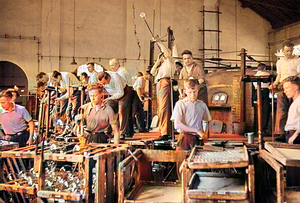GleamCo
The Ketsire Liveried Company of Lamp Makers t/a GleamCo is a Ketsire-based company that advertises itself as the preeminent manufacturer and supplier of sodium-based lighting equipment to the Benacian Union.
As a privately owned manufacturer GleamCo received its livery and charter from the Chapter of the Worshipful Guild of Artificers established in Ketsire. The rapid political assent of Brugen Aldef, the founder and proprietor of the company, placed him in an advantageous position vis the Guild, and as such it is widely believed that whatever dues GleamCo now pays are purely nominal and more than reimbursed via indirect benefits.
The idea that there was a demand for sodium-vapor lamps originated when Brugen Aldef, who owned a light-bulb manufacturing plant in Ketsire, found that nearly all public lighting still functioning in the devastation following the Scouring were street lights using that same technology. In 1697, he invested in converting his factory into GleamCo, the first company to market luxury sodium lamps or "sand lamps". The efficiency, craftsmanship, and reliability against remnant nuclear footprints of these sand lamps had orders flowing in steadily from the Cult of the Sacred Detonation, then flooding from across the Sovereign Confederation. By 1705, the once dark nights in those singed corners most crippled by electromagnetic disturbances were made tastefully well-lit.
In 1711, Aldef announced plans for development of a GleamCo Engineering Campus to develop his employees' skills and offer apprenticeships to aspiring youths. In 1716, construction on its final research wing concluded and now produces the EZEC.

